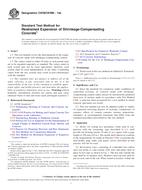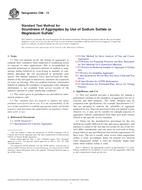Potřebujeme váš souhlas k využití jednotlivých dat, aby se vám mimo jiné mohly ukazovat informace týkající se vašich zájmů. Souhlas udělíte kliknutím na tlačítko „OK“.
ASTM C586-11
Standard Test Method for Potential Alkali Reactivity of Carbonate Rocks as Concrete Aggregates (Rock-Cylinder Method)
Automaticky přeložený název:
Standardní zkušební metoda pro potenciální alkalickém reaktivita karbonátových hornin, jako betonové směsi (Rock-Cylinder Method)
NORMA vydána dne 1.10.2011
Informace o normě:
Označení normy: ASTM C586-11
Poznámka: NEPLATNÁ
Datum vydání normy: 1.10.2011
Kód zboží: NS-14128
Počet stran: 5
Přibližná hmotnost: 15 g (0.03 liber)
Země: Americká technická norma
Kategorie: Technické normy ASTM
Kategorie - podobné normy:
Anotace textu normy ASTM C586-11 :
Keywords:
aggregate, alkali reactivity, carbonate rocks, concrete, deleterious expansion: Aggregate (potential alkali reactivity), Carbonate aggregates, Cement-aggregate combinations, Rock materials/properties/analysis, ICS Number Code 91.100.30 (Concrete and concrete products)
Doplňující informace
| Significance and Use | ||||||||||||
|
This test method is intended to give a relatively rapid indication of the potential expansive reactivity of certain carbonate rocks that may be used as concrete aggregates. The test method has been successfully used in (1) research and (2) preliminary screening of aggregate sources to indicate the presence of material with a potential for deleterious expansion when used in concrete. The test method is intended as a research and screening method rather than as the basis of a specification requirement. It is intended to supplement data from field service records, petrographic examinations according to Guide C295, and tests of aggregate in concrete according to Test Method C1105. Alkalies participating in the expansive reactions with aggregate constituents in concrete usually are derived from the hydraulic cement; under certain circumstances they may be derived from other constituents of concrete or from external sources. Two types of alkali reactivity of aggregates are recognized: (1) alkali-silica reaction involving certain siliceous rocks, minerals, and artificial glasses, and (2) alkali carbonate reaction involving dolomite in certain calcitic dolomites, dolomitic limestones, and dolostones. This test method is not suitable as a means to detect alkali-silica reaction. |
||||||||||||
| 1. Scope | ||||||||||||
|
1.1 This test method covers the determination of the expansion of a specimen of carbonate rock while immersed in a solution of sodium hydroxide (NaOH) at room temperature. The length changes occurring during such immersion indicate the general level of reactivity of the rock and whether tests should be made to determine the effect of aggregate prepared from the rock upon the volume change in concrete. 1.2 This standard does not purport to address all of the safety concerns, if any, associated with its use. It is the responsibility of the user of this standard to establish appropriate safety and health practices and determine the applicability of regulatory limitations prior to use. 1.3 The values stated in SI units are to be regarded as standard. No other units of measurement are included in this standard. |
||||||||||||
| 2. Referenced Documents | ||||||||||||
|
Podobné normy:
Historická
15.2.2010
Historická
1.7.2011
Historická
15.12.2010
Historická
1.7.2014
Historická
1.8.2013
Historická
1.12.2013



 ASTM C858-10e1
ASTM C858-10e1 ASTM C869/C869M-11..
ASTM C869/C869M-11.. ASTM C873/C873M-10a..
ASTM C873/C873M-10a.. ASTM C878/C878M-14a..
ASTM C878/C878M-14a.. ASTM C88-13
ASTM C88-13 ASTM C881/C881M-13..
ASTM C881/C881M-13..
 Cookies
Cookies
